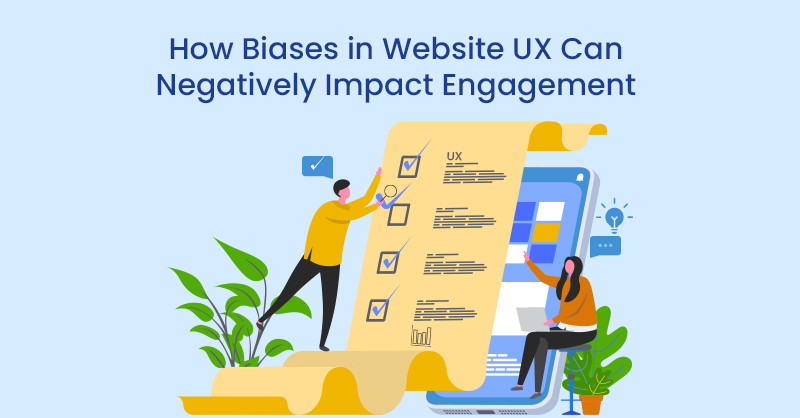Did you know that only about a quarter of businesses are satisfied with their engagement rates? Did you also know that the average engagement rate on a website is a little over 2%, but the best companies have a rate of about 11%?
Although 11 out of every 100 visitors on your website taking the desired action may not seem like a lot, it is, especially if those 11 people are making a purchase and turning into long-term customers.
That said, better engagement rates result from intentional work, particularly on your website design and user experience. For a seamless website UX that drives engagements, one area of focus must be addressing biases that impact engagements.
Before we dive into why biases play a part in your engagement rate, let’s explore how UX can impact engagement rates.
How UX Can Impact Engagement Rates
A negative browsing experience on your website could be the difference between a visitor completing a purchase and abandoning your site entirely. Because website UX influences how someone proceeds with a business, company leaders use data analytics to monitor their website's performance constantly.
Not only do data analytics tools help inform companies of how visitors are moving through their sites, but they can also give insights into what biases might harm and help their engagement rate.
Here’s a deeper look into how UX can impact engagement rates.
Brand perception
How someone interacts with your brand is heavily influenced by their perception of it. For instance, if a user accesses your website and it’s cluttered and inefficient, they won’t have a good experience.
And that experience will likely leave a bad taste in their mouth about your brand generally. As a result, they probably won’t follow through with their purchase or sign up, let alone return to your site.
Ultimately, visitors will share their experiences with your website. If word gets around that your website UX isn’t up to par, it could result in overall negative brand perception.
Navigation
When visitors can’t access what they need, find the desired product, checkout page, or another crucial piece of information that would turn them from a visitor to a customer, they won’t convert.
On the other hand, when a site has simple navigation, an easily accessible menu, organized content, and an intuitive checkout process, it prompts visitors to have an excellent experience on the site.
All in all, good navigation is influential in UX design and must not be taken lightly when trying to boost engagement rates.
Quality leads
UX has a lot to do with the quality of leads that visit your site. When you find out what constitutes a solid UX on your website for your ideal customers, you can design the features and functions that make that experience a reality.
The more your website is tailored to your target audience, the better chance you will attract quality leads that end in conversions. However, if you don’t factor in your ideal customers when designing your website UX, it will appeal to a general audience, at best. And unfortunately, a broad audience isn’t conducive to a high engagement rate.
Accessibility
Accessibility is becoming more and more of a priority for companies that want to better their customer relationships and, in turn, improve their engagement rates. Millions of people live with at least one disability. The disability they live with affects their day to day, including how they navigate online spaces and platforms.
When companies don’t prioritize accessibility in the website UX, they’re essentially neglecting the needs of a massive pool of users with millions in buying power.
When your site is accessible, it becomes more welcoming and functional for those living with a disability. As a result, this massive pool of users will be drawn to your site over your competitors and be more willing to carry out the desired action with your brand.
Now, let’s look at where biases come into play regarding engagement rates.
Why Biases Play a Part in Engagement Rates

First, biases play a part in engagement rates because they affect how a designer creates the user experience.
For example, if a designer feels a certain way about a function or feature, whether the user feels the same way or not, that bias can lead to the designer altering the design. As a result, that feature or function may not resonate with users and ultimately affect whether they take the desired action on your site.
Users also have biases that come into play when they engage with digital spaces. For instance, let’s say a user already has thought about how something should work. In that case, if you do the opposite of what they’re expecting, it could harm their UX and dissuade them from converting.
Let’s look at three types of bias and how they can play a part in website UX and ultimately lead to low engagement rates.
Optimism bias
Optimism bias can have serious effects on your UX, engagements, and conversions: “Despite known risks or even recognizing danger, optimism bias can drive intelligent people to ignore warnings or cut corners out of the belief that the worst simply won’t happen to them.”
In this case, if a designer doesn’t think that cutting a few corners in the process will have a negative outcome, unfortunately, most will take the risk. But if that optimism bias negatively affects the team, it could cause rifts that disrupt the workplace. It could also ruin your chance at creating lasting relationships with users that result in repeat purchases and long-term brand loyalty.
You can combat this bias by ensuring compliance and awareness are a part of your design team’s culture. For example, if your data is telling you that customers like design A instead of design B, go with design A — no matter how optimistic you feel about design B. Don’t let your bias and what you want blind you to what the customer wants and what will ultimately work.
Framing
Framing refers to the context people use to describe what they’re talking about, whether an idea, question, or decision. How situations are framed in the design process influence which functions, features, and solutions designers move forward with on a website.
For example, if a designer emphasizes that their users are tech-savvy but leaves out that their users are also living with a disability, that would affect how they move forward with the UX design.
You can combat this bias by refraining from compulsive decision-making and learning as much as you can about a situation before making adjustments to the UX design.
Perceived value bias
Perceived value bias refers to the value we place on a product or service based on how it looks or how it’s presented to us.
For example, when a user is presented with a low-quality site that is confusing to use, they won’t see that site as valuable. On the other hand, if a user is presented with a top-tier, intuitive, navigable site, they’re more likely to deem it useful and, hopefully, make a purchase or carry out another conversion.
Combat this bias by understanding what is valuable to your users and designing everything on your site with that knowledge in mind. Do A/B testing and surveys to determine whether or not your app or website has perceived value on par with your actual value, and make changes from there.

Improve Your Website UX to Positively Impact Engagements Instead
With all of the above information in mind, you’re right to want to do everything you can to improve your website UX to positively impact engagement. Minimizing biases in your website UX may seem like an arduous task, but a few simple actions can boost your engagement rate.
Start by understanding what biases are out there and how they affect decision-making and behaviours. Next, learn what constitutes ethical use of biases. How can you get people to take your desired action without being pushy in approach or unnatural in design?
Then, be sure to measure the user experience and study how users are navigating your site. In addition, gather feedback from users and internal teams on how to improve the user experience.
Ultimately, there is no single right answer when it comes to addressing biases in website UX. However, better engagement rates will come if you prioritize user needs over everything in the design process.





